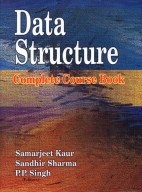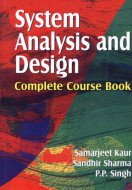Samarjeet Kaur; Sandhir Sharma and P P Singh (3 results)
Product Type
- All Product Types
- Books (3)
- Magazines & Periodicals
- Comics
- Sheet Music
- Art, Prints & Posters
- Photographs
- Maps
-
Manuscripts &
Paper Collectibles
Condition
- All Conditions
- New
- Used
Binding
- All Bindings
- Hardcover
- Softcover
Collectible Attributes
- First Edition
- Signed
- Dust Jacket
- Seller-Supplied Images
- Not Printed On Demand
Seller Location
Seller Rating
-
Data Structure : Complete Course Book (Reprint)
Published by Deep and Deep, 2019
ISBN 10: 8176297739ISBN 13: 9788176297738
Seller: Vedams eBooks (P) Ltd, New Delhi, India
Book
Hardcover. Condition: As New. Contents Preface. 1. Programming principles styles and guidelines. 2. Phases of software engineering. 3. Arrays. 4. Multidimensional arrays and sparse matrices in data structure. 5. Stacks and recursion. 6. Sophisticated examples of recursion. 7. Queues. 8. Problem and expression on polish notation. 9. Linked list. 10. Tree structures and its types. 11. Variations on tree structures. 12. Graphs and networks. 13. Sorting. 14. Search strategies. 15. Data structures and data management. Glossary. Bibliography. Index. Data Structure provides a practical introduction to data structures and algorithms from the viewpoint of abstract thinking and problem solving as well as the use of C++. The most unique aspect of this text is the clear separation of the interface and implementation. C++ allows the programmer to write the interface and implementation separately to place them in separate files and compile separately and to hide the implementation details. This separation of interface and implementation promotes abstract thinking. Class interfaces are written and used before the implementation is known forcing the reader to think about the functionality and potential efficiency of the various data structures (e.g. hash tables are written well before the hash table is implemented). This book is a complete text book for data structure course in undergraduate and advanced studies. 876 pp.
-
System Analysis and Design : Complete Course Book
Published by Deep and Deep, 2006
ISBN 10: 8176297690ISBN 13: 9788176297691
Seller: Vedams eBooks (P) Ltd, New Delhi, India
Book
Hardcover. Condition: As New. Contents Preface. 1. Introduction to information systems development. 2. Managing the application development. 3. Systems analysis. 4. Data modeling. 5. Process modeling. 6. Network modeling. 7. Object modeling. 8. Systems design and construction. 9. Application architecture and process design. 10. Input design and prototyping. 11. Database design. 12. Output design and prototyping. 13. User interface design and prototyping. 14. Designing of software. 15. Design of files and use of auxiliary storage devices. 16. Design for data communications. 17. Program design. 18. Productivity tools. 19. Project management. 20. Strategic planning. 21. Security disaster/recovery and ethics in system development. 22. Quality assurance. Glossary. Bibliography. Index. Complex challenging and stimulating this book addresses system analysis and design it is full of information that shows the organizational process that a team of business and systems professionals use to develop and maintain computer based information systems. It stresses the importance of responding to and anticipating problems through innovative uses of information technology. This complete course book presents students with real world system analysis skills and techniques within the framework of the Systems Development Life Cycle (SDLC). Examples and cases are drawn from actual systems projects that enable students to learn in the context of solving problems much like the ones they will encounter on the job. Students will find concepts easy to understand through the clear writing style combined with figures that illustrate current technology and concepts. The book provides an excellent text for systems development then goes on to making the business case analysis design implementation and maintenance. For future systems analysts or for those information technology that need a great resource for implementing new ideas and strategies for success. 758 pp.
-
Software Engineering : Complete Course Book
Published by Deep and Deep, 2006
ISBN 10: 8176297712ISBN 13: 9788176297714
Seller: Vedams eBooks (P) Ltd, New Delhi, India
Book
Hardcover. Condition: As New. Contents Preface. 1. Introduction. 2. Software processes. 3. Planning a software project. 4. Function oriented design. 5. Coding. 6. Testing. 7. System engineering. 8. Analysis concepts and principles. 9. Analysis modeling. 10. Design concepts and principles. 11. Design methods. 12. Design for real time systems. 13. Software testing techniques. 14. Software testing strategies. 15. Technical metrics for software. 16. Case study warehouse management system. 17. Case study telecom. 18. Managing object oriented software engineering. 19. Data acquisition weather monitoring station. 20. Frameworks foundation class library. 21. Client/server computing inventory tracking. 22. Artificial intelligence cryptanalysis. 23. Command and control traffic movement. 24. Formal methods. 25. Cleanroom software engineering. 26. Software reuse. 27. Reengineering. 28. Client/server software engineering. 29. Computer aided software engineering. 30. The road ahead. Bibliography. Index. This book provides a comprehensive material of software engineering techniques and their application in practical software projects. This book takes a broad perspective to software engineering offering readers solid coverage of the software process and software process technology system integration requirements management and risk analysis as well as pattern based reuse distributed system engineering and legacy systems. We have incorporated coverage of new software development paradigms namely agile methods and component based software engineering along with dependability issues availability security and critical systems making the book more in tune with current technology and practice. This book is designed to be used as a complete textbook of software engineering (development management and evolution) especially with regard to system requirements engineering and critical systems. 914 pp.




